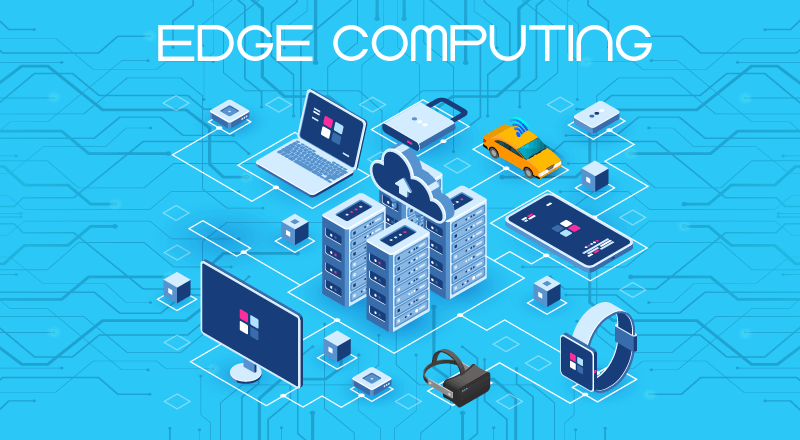The Power of Edge Computing and How It Will Revolutionize the Digital Landscape
Uncategorized Uncategorized
The Power of Edge Computing and How It Will Revolutionize the Digital Landscape
The notion of edge computing has arisen as a transformational force in the ever-evolving landscape of technology, challenging old paradigms and redefining the way in which we handle and analyze data. This has occurred as a result of the concept of edge computing’s ability to challenge traditional paradigms. Edge computing has emerged as a critical answer as we stand on the precipice of a new age, when the need for real-time, low-latency applications is at an all-time high. This solution holds the promise of redefining the boundaries of what is possible in the digital environment.
Understanding Edge Computing in the Context of a Shift in Paradigm
At its foundation, edge computing marks a shift from the centralized paradigm of data processing that has been the standard for several decades. This approach has been the norm for the majority of the computer industry. Edge computing includes processing data closer to the source, or directly at the “edge” of the network, as opposed to the traditional technique, which requires sending data to a centralized cloud server for processing. In this approach, the data is transmitted to be processed. Because of its close closeness to the original source of the data, the system has a lower latency, improved performance, and the ability to make decisions almost instantly.
The expanding limits of centralized cloud systems have led to the growth of edge computing as a solution to these restrictions. While cloud computing has been helpful in driving innovation and efficiency, certain applications require a level of responsiveness that centralized models struggle to achieve. Cloud computing has been instrumental in driving innovation and efficiency. Take for example the realm of driverless cars, augmented reality, or industrial automation, all of which include situations in which split-second choices are absolutely necessary. In situations like these, the number of milliseconds saved by processing data at the edge might make all the difference in whether or not an endeavor is successful.
The Principal Elements That Comprise Edge Computing
1. Devices at the Periphery:
The edge devices, which include smart sensors, Internet of Things devices, and other endpoints that create and gather data, are the most important component of edge computing. These devices serve as the initial point of contact in the trip of data processing, gathering information from the physical world and starting the process of computing.
2. Computing Nodes at the Network’s Edge In addition to the devices themselves, edge computing also entails the installation of computer nodes at the network’s farthest reaches. These nodes might be anything from modest data centers to robust servers that are positioned in such a way as to do data processing on a local level. Edge computing helps to limit the need for data to travel over long distances by dispersing processing closer to the source of the data. This helps to reduce latency and optimize performance.
3. Platforms for Computing at the Edge:
Specialized platforms have recently come into existence in order to efficiently manage and coordinate the scattered nature of edge computing. At the edge of the network, these platforms offer a uniform environment for the creation, deployment, and management of applications. They frequently contain tools for real-time analytics, device management, and security, which enables businesses to use the full potential of edge computing.
Advantages of Utilizing Edge Computing:
1. Low Latency: The ability of edge computing to provide experiences with low latency is one of the key benefits offered by this type of computing. Edge computing reduces the amount of time required for information to travel from the device to the processing node and back again by processing data in close proximity to the original source of the data. This is especially important in applications where real-time responsiveness is of the utmost importance, such as gaming, virtual reality, and critical infrastructure, amongst others.
2. Optimization of Bandwidth: Edge computing helps to reduce the strain placed on network bandwidth since it processes data on a local level. This is especially helpful in circumstances in which a tremendous volume of data is created, such as in smart cities that have a large number of linked devices. When data is handled at the edge, only the information that is relevant needs to be forwarded to the central cloud. This helps to reduce the burden that is placed on the network infrastructure.
3. Enhanced Security: at this day and age, data security is of the utmost importance, and edge computing provides an additional layer of protection by storing sensitive information at a location that is physically closer to the point of origin. This lessens the likelihood of illegal access occurring while the data is in transit and limits the attack surface. In addition, localized processing makes it possible for security risks to be identified and countered in a more timely manner, which in turn strengthens the system’s overall resilience.
This paradigm change is not only a technology progression; rather, it is a revolution that will redefine the possibilities of our digital future. As we continue our investigation into the world of edge computing, it is becoming increasingly obvious that this shift is not merely a technological evolution. In the following paragraphs of this article, we will go further into various sectors and use cases where edge computing is making a concrete effect, and we will also investigate the obstacles and concerns that come with adopting this game-changing technology.
Applications across a Wide Range of Industries Bringing Out One's Full Potential
**1. Healthcare: The application of edge computing is proven to be a game-changer in the healthcare industry. Real-time monitoring and analysis of patient data is made possible by the capability to process patient data at the edge of the network. This makes it possible to respond more quickly to urgent circumstances. Wearable technology and medical sensors have the ability to gather and evaluate vital signs locally, providing medical personnel with rapid insights into the state of their patients. This not only improves the treatment that is provided to patients, but it also lessens the burden that is placed on centralized healthcare systems.
**2. Manufacturing and the Fourth Industrial Revolution:
The implementation of edge computing is identical with the term “Industry 4.0” in the context of the manufacturing industry. The use of edge devices and computer nodes in smart factories makes it possible to do predictive maintenance, monitor the health of equipment in real time, and improve production processes. **3. Retail and consumer Experience: Retailers are using the potential of edge computing to tailor consumer experiences. This allows manufacturers to reduce downtime, improve efficiency, and make choices based on data, which drives overall productivity. Retailers are able to provide more relevant specials and recommendations to customers both online and in traditional stores by doing real-time analysis of data relating to the behavior of customers. This not only increases customer happiness but also the operational effectiveness of the business by streamlining the procedures involved in inventory management and supply chain operations.
**4. Driverless Cars and Trucks:
The automobile sector is leading the way in the use of edge computing, notably in the creation of autonomous cars. These cars are able to make split-second judgments without having to rely on a remote cloud server since the data from their internal sensors and cameras is processed locally. Because of this, drivers will have an experience that is both safer and more responsive behind the wheel, which is essential for the mainstream adoption and incorporation of autonomous technology.
Edge computing presents a number of challenges and requires careful consideration.
**1. Data Security and Privacy: While edge computing can improve data security in certain respects, it also creates new problems to solve. Processing data in a distributed manner results in the introduction of new sources of vulnerability, which must be handled. For maximum protection against potential security flaws, the security protocols on edge devices and nodes need to be as strong as possible. Additionally, because edge computing is decentralized, careful consideration of data privacy is required, which is especially important in sectors that deal with sensitive information, such as the healthcare and financial industries.
**2. Interoperability and Standardization: The varied variety of devices and systems that are involved in edge computing raises issues that are connected to interoperability. Standardized protocols are necessary in order to accomplish the goals of ensuring flawless communication and collaboration between the various edge devices and platforms. **3. Scalability and Management: Scaling edge computing installations may be a challenging process. It is vital for the industry as a whole to make efforts to develop common standards in order to make the most of the potential of edge computing and enable a more cohesive and linked ecosystem. Keeping track of and caring for the infrastructure is going to become an increasingly pressing issue as the number of edge devices and nodes continues to rise. Computing systems at the edge need to provide comprehensive management tools in order to effectively handle large scales. Automation and intelligent orchestration are two essential elements that must be present in order to achieve smooth scaling without sacrificing performance.
**4. Integration of the Edge with the Cloud:
Although edge computing offers instant processing advantages, this does not diminish the significance of centralized cloud resources. For a data processing strategy to be comprehensive and effective, it is vital to realize a harmonic integration between components located on the edge and in the cloud. In order to build an infrastructure that is both comprehensive and flexible, businesses need to find the sweet spot between edge and cloud computing and capitalize on the advantages offered by each.
The Prospects for Edge Computing in the Future: Exploring Uncharted Territories
As we peer beyond the horizon of the future, the path of edge computing looks to be headed in the direction of unceasing expansion and innovation. Further developments in edge computing capabilities will be driven by the continual evolution of technology as well as the growing need for applications that operate in real time. Edge devices are anticipated to grow more advanced, with increased processing power and capabilities related to artificial intelligence. This will enable them to carry out more complicated activities in their local environments.
Synergies will be created as a result of the convergence of edge computing with other paradigm-shifting technologies, such as 5G networks and artificial intelligence, which will magnify the effect of each individually. The high speed and low latency capabilities of 5G will significantly enhance the performance of edge computing, which will in turn open up new doors of opportunity in fields such as augmented reality, smart cities, and remote healthcare.
The use of artificial intelligence at the edge of the network will provide devices the ability to make decisions that are more intelligent and aware of their context, therefore opening the way for a new era of autonomous systems. The combination of AI with edge computing has tremendous potential for a wide range of applications, from smart homes that anticipate the requirements of their occupants to industrial robots that can adapt to changing circumstances.
The Overcoming of Obstacles as a Roadmap to Successful Edge Computing
In the process of navigating the terrain of edge computing, it is crucial for companies to perceive the problems as opportunities for development and refinement in their practices. In order to effectively address these difficulties, a strategic strategy that emphasizes the development of innovative technology solutions, the cultivation of productive working relationships, and a dedication to ongoing quality enhancement is required.
1. Spending Money on Precautionary Safety Measures:
Investing in effective security mechanisms at both the device and network levels is something that businesses need to do if they want to strengthen the security posture of edge computing. It is very necessary to put encryption, authentication protocols, and secure boot methods into place in order to guard the integrity of the data. Audits and upgrades to the security system on a regular basis guarantee that any vulnerabilities are addressed as soon as possible, therefore establishing a foundation for robust security.
**2. Driving Interoperability Through Standards: The industry as a whole has to work together in order to build common standards that will promote interoperability across a variety of edge devices and platforms. Standardization not only makes integration easier, but it also speeds up the process of developing and deploying edge computing solutions. Efforts made collectively to create and accept open standards will encourage the growth of an edge ecosystem that is more coherent and linked.
Scalability via Automation: As edge computing installations grow in size, automation becomes an increasingly important factor in determining how efficiently they operate. Provisioning, monitoring, and maintenance procedures that are automated relieve the strain placed on IT workers and make it possible to scale up without disruption. Investing in intelligent orchestration technologies guarantees that edge computing systems may dynamically react to changing needs without compromising performance. This can be accomplished without compromising security.
**4. Strategic Integration of the Edge with the Cloud:
For a complete data processing strategy, striking the correct balance between the resources provided by the edge and those provided by the cloud is essential. Architectures should be designed for organizations that take use of the positive aspects of both paradigms. While centralized cloud resources are responsible for managing large-scale data storage, analytics, and sophisticated workloads, edge devices are able to handle real-time processing and decision-making. The benefits of edge computing and cloud computing may both be maximized by adopting a method that is effectively integrated.
The Effects of Edge Computing on Society and the Economy
In addition to the technological ramifications, edge computing is positioned to have a significant influence on the socioeconomic landscape. Individuals and communities are given more power when computing power is made more accessible through edge devices, which also helps to stimulate innovation at the grass-roots level. The processing of data on a local level makes it possible to develop solutions that are specifically suited to meet the requirements of a given situation. These solutions might range from innovative agricultural techniques in rural regions to community-based healthcare initiatives.
The implementation of edge computing in less economically developed areas has the potential to reduce the digital divide by expanding access to more modern technologies, which were previously only available in more developed areas. This all-inclusive strategy not only improves the quality of life, but it also helps to spur economic growth by encouraging the establishment of new enterprises and the creation of new employment opportunities.
Taking a Glimpse Into the Future: Ethical Considerations and Responsible Innovation
As the impact of edge computing continues to grow, it is more important than ever to take ethical issues into account. It is imperative that businesses make responsible innovation a top priority by addressing concerns around data privacy, algorithmic bias, and the ethical use of artificial intelligence at the edge. For the purpose of establishing clear norms and ethical frameworks to control the deployment of edge technologies, which will ensure that the advantages will be achieved without jeopardizing individual rights or society values, respectively, should be developed.
In order to make ethical use of edge computing, one must look beyond purely technological concerns and consider the wider societal ramifications of their actions. To successfully shape a future in which edge computing makes beneficial contributions to society, it is essential to engage with many stakeholders, including legislators, ethicists, and the general public.
Acceptance of a Secure Digital Future in Concluding Statements
As we draw to a close on our investigation of edge computing, it has become abundantly clear that the paradigm change that we have been discussing is more than simply a passing technical fad; rather, it is a driving force behind a resilient and responsive digital future. The capacity of edge computing to push the boundaries of what is possible, so stimulating innovation and redefining the way in which people interact with and make use of technology, is at the heart of the technology’s revolutionary power.
In order for enterprises to unlock the full potential of edge computing, they must first overcome barriers, then embrace collaborative standards, and finally support responsible innovation. It is our collective obligation to manage this revolutionary path with foresight, ethical concerns, and a dedication to establishing a digital environment that benefits all of mankind as we stand on the cusp of a new era. The age of edge computing has here, and with it comes a wealth of opportunities; now is the time for us to grab these chances with determination and foresight.

Geeta Technical Hub
Related Posts
Hantavirus
Hantavirus Hantaviruses are zoonotic agents that can have serious detrimental effects on people. This pertains to a group of viruses that are mainly transmitted by rodents and can lead to severe illnesses in people, such as Hanta virus CardioPulmonary Syndrome
Lifelong Learning and Continual Adaptation in AI Systems
Introduction: The Next Frontier of Intelligent Systems Artificial Intelligence has reshaped the technological landscape, bringing automation, prediction, and personalization into the mainstream. However, one of its most significant limitations lies in its rigidity. Once a model is trained, it generally

What should be done for a BCA? – Geeta University
What should be done for a BCA? – Geeta University Geeta University offers a Bachelor of Computer Applications (BCA) degree that equips students with the necessary skills to pursue careers in the field of computer science. With the increasing demand


